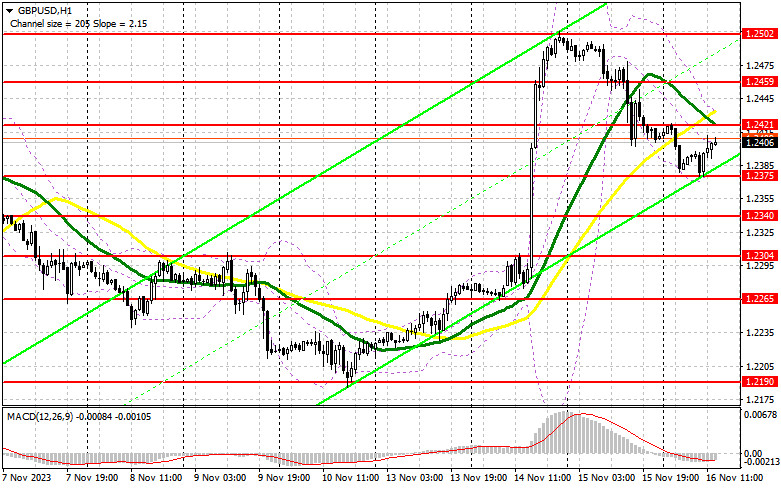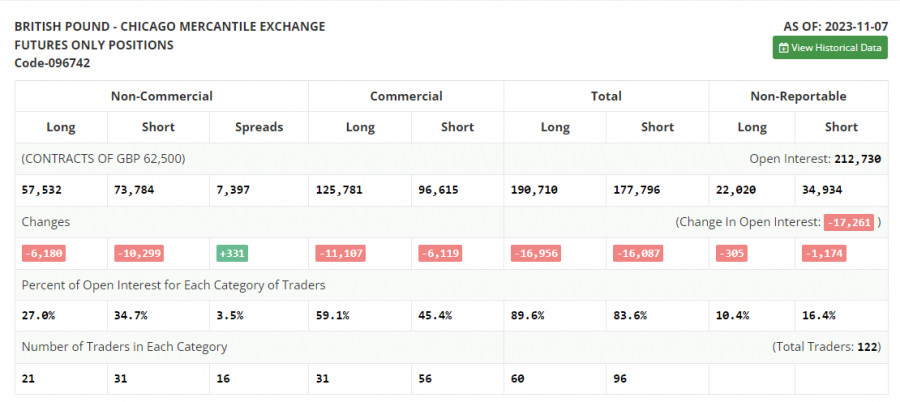
In my morning forecast, I drew attention to the level of 1.2375 and recommended making entry decisions based on it. Let's look at the 5-minute chart and analyze what happened there. The decline and the formation of a false breakout at this level allowed for an entry point into long positions, resulting in a pair's rise by more than 30 points. The technical picture still needs to be revised for the second half of the day.

To open long positions on GBP/USD, the following is required:
Now, everything will depend on US statistics. A report on the number of initial claims for unemployment benefits in the United States is expected. Still, the data on the Philadelphia Fed Manufacturing Index and changes in industrial production volume will be much more interesting. Speeches by FOMC members John Williams, Loretta Mester, and Christopher Waller could also lead to a volatility spike, but their statements are unlikely to help the dollar recover its losses. In the event of a pair's decline after the reports, only the formation of a false breakout at 1.2375, similar to what I discussed earlier, will confirm the correct entry point into long positions in continuation of the bullish scenario. The target remains today's high at 1.2421. A breakthrough and consolidation above this range will lead to a new signal to open long positions, with an exit at 1.2459. The ultimate goal will be the area of 1.2502, where I will make profits. In the scenario of the pair's decline and the absence of buyer activity at 1.2375 in the second half of the day, as this level has already worked once today, pressure on the pair will increase. A false breakout around the next support at 1.2340 will signal the opening of long positions. I plan to buy GBP/USD only on a rebound from 1.2265, with a correction target of 30-35 points within the day.
To open short positions on GBP/USD, the following is required:
Despite the unsuccessful attempt to establish itself at daily lows, the bears are still in full control. In the case of further pair growth, only the formation of a false breakout at 1.2421, where the moving averages pass, will signal the opening of short positions in anticipation of a new downward movement toward the support at 1.2375. A breakthrough and reverse test from the bottom to the top of this range will deal a more serious blow to buyer positions, triggering stop orders and opening the way to 1.2340. The more distant target will be the area of 1.2304, where I will take profits. In the event of a GBP/USD rise and the absence of activity at 1.2421 in the second half of the day, which is likely to happen only after soft statements by Fed representatives, buyers will have a chance to return to the upward trend. In this case, I will postpone sales until the false breakout at 1.2459. Without downward movement, I will sell GBP/USD immediately on a rebound from 1.2502, but only counting on a pair correction down by 30-35 points within the day.

In the COT report (Commitment of Traders) for November 7, there was a reduction in long and short positions, but the balance of power remained the same. Pressure on the pound was observed throughout the week since the released report on the growth rate of the UK economy disappointed, indicating real chances of a recession as early as the fourth quarter of this year. Considering the statements of Bank of England policymakers on interest rates, which are expected to remain at a high level for a fairly long period, the chances of a significant rise in the British pound are quite small. The only thing that can change the market dynamics is weak US statistics, indicating further easing price pressure. The more talk there is about the possibility that US rates will remain unchanged in December of this year, the stronger the pressure on the US dollar and the more expensive the pound will become. The last COT report stated that long non-commercial positions decreased by 6,180 to the level of 57,532, while short non-commercial positions fell by 10,299 to the level of 73,784. As a result, the spread between long and short positions increased by 310. The weekly price rose and reached 1.2298 against 1.2154.

Indicator Signals:
Moving Averages:
Trading is conducted below the 30 and 50-day moving averages, indicating the likelihood of a pound decline.
Note: The author considers the period and prices of moving averages on the hourly chart H1 and differs from the general definition of classical daily moving averages on the daily chart D1.
Bollinger Bands:
In the case of a decrease, the lower boundary of the indicator at 1.2375 will act as support.
Description of Indicators:
Moving Average (MA) is a tool for smoothing volatility and noise in the current trend determination. The period is 50. It is marked on the chart in yellow.Moving Average (MA) is a tool for smoothing volatility and noise in the current trend determination. The period is 30. It is marked on the chart in green.Moving Average Convergence/Divergence (MACD) is a trend-following momentum indicator that shows the relationship between two moving averages of a security's price. Fast EMA – period 12. Slow EMA – period 26. SMA – period 9.Bollinger Bands represent a volatility indicator consisting of two bands drawn at a certain distance above and below the simple moving average (SMA) of a security's price. The period is 20.Non-commercial traders are speculators, such as individual traders, hedge funds, and large institutions, using the futures market for speculative purposes and meeting certain requirements.Long non-commercial positions represent the total long open position of non-commercial traders.Short non-commercial positions represent the total short open positions of non-commercial traders.The total non-commercial net position differs between non-commercial long and short positions.